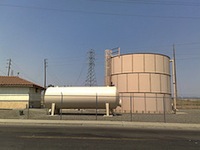 An above ground storage tank can seem like a no-brainer choice over underground storage of hazardous substances. After all, the tank is there where you can easily see it. But you still have to follow specific procedures and precautions to ensure your tank is safe and secure.
An above ground storage tank can seem like a no-brainer choice over underground storage of hazardous substances. After all, the tank is there where you can easily see it. But you still have to follow specific procedures and precautions to ensure your tank is safe and secure.
Here are five best practices you can adopt to maintain your above ground storage tank:
1. Labeling.
Government regulations require proper labeling of each above ground storage tank as well as its associated piping and valves. Labels must include industry-standard colors and symbols that indicate what’s being stored inside the tank.
But proper labeling has more value than regulatory compliance. It’s an essential safety tool. If your employees or anyone else who has contact with the tank cannot quickly and correctly determine what’s inside, you’ve opened yourself to numerous potential problems. Mistaken dispensing can produce damaging results as well as waste product. Mistaken refilling could produce equally dangerous consequences.
Mistaken identity could also put your employees at increased personal health or safety risk, depending on what you’re storing in the tank. Many hazardous chemicals require specific equipment or clothing or procedures for handling. But if your product is mislabeled, how will employees know what precautions to take?
2. Cleanliness.
Remove rainwater or debris if you have a diked system. That area surrounding your above ground storage tank is supposed to be empty, in case something catastrophic happens and all or a large portion of your tank’s contents spill out. If the space is constricted by litter or water, it cannot do its containment job. And you can’t see if there are potential problems lurking underneath water or debris.
Proper filling and dispensing techniques are designed to avoid spills, which aren’t just messy and wasteful, they’re a storage “failure” that may require official reporting. You’ll save time and hassle by ensuring your people know best-practice procedures.
3. Accurate record-keeping.
Know what’s required in the way of ongoing monitoring – what you have to track daily, weekly or monthly. Maintaining your records in an easy-to-access location will make your internal management easier, and things will go faster and more smoothly when it’s time for an official inspection. Your good organization is a sign you’re probably meeting equally high standards in terms of overall maintenance of your above ground storage tank.
In addition to your monitoring records, your inspector will want to see a few other things, including proof of when you purchased the above ground storage tank, materials used to construct it, and of course, what you’re storing inside.
4. Regular inspection.
You can count on that official inspection noted above. But best practices for maintaining an above ground storage tank call for you to do your own inspections, too. It just makes good sense. Even if you have electronic monitoring systems, they don’t have eyes so they can’t detect every potential problem.
The sooner you’re able to detect problems such as leaks or spills, the faster you can handle the situation with least cost or down time. And when it comes to details like cathodic protection, visual inspection is the best tool for the job.
While you’re inspecting, you’ll want to be sure your tank is properly seated and off the ground. A concrete pad and raised feet are your best foundation, ensuring air circulation underneath as well as level positioning.
5. Emergency plan.
There’s a reason companies that store or handle hazardous substances are required to prepare and maintain an emergency action plan. Following all best practices relating to maintaining your above ground storage tank certainly helps ameliorate risk, but sometimes things go wrong.
Is your emergency plan up to date? Does everyone know what’s in it, and where to find it immediately if an accident occurs?
Instituting best practices for maintaining your above ground storage tank will ensure your facility and personnel remain safe and your tank has a long, productive life.
Photo Credit: Al Pavangkanan via Flickr
